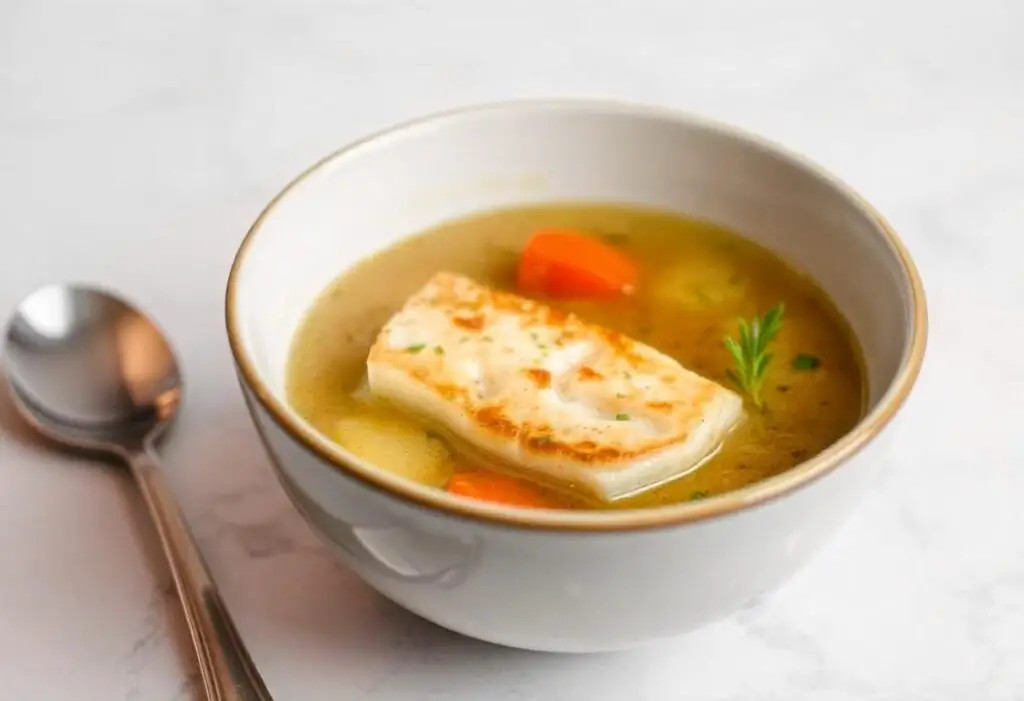Table of Contents
Introduction: The Comfort of Poached Fish Soup

In the culinary tour of the world, few dishes can bring up the same senses of warmth and nostalgia as a bowl of steaming poached fish soup. Delicate flavors and wholesome ingredients sum up comfort food to perfection, at least in cooler weather. Maybe you’re nursing a cold, seeking a warm family dinner, or perhaps you just need a rich meal to fill your bellies; poached fish soup is the nourishing answer.
Poached fish soup reflects simplicity and quality. It would showcase fish so tender and flaky; the star of it all would be the broth of fresh herbs and aromatic vegetables. It’s a very versatile dish in the way you can serve it, really easily adapts to your taste or season. This article will guide you step by step on how to make your poached fish soup fresh from the ingredients up, including mastering that tricky technique of poaching and a few other tasty variations for that matter.
Ingredients That Sing: What You’ll Need for Poached Fish Soup
Ingredients will form the heart of any soup. For poached fish soup, you have to ensure that the components used are of a quality that will infuse into the entire recipe. This is what you’ll need:
Fresh Fish Selection
One very important success factor for poaching is the choice of fish used in the soup. Fresh and sustainable sources can provide maximum flavor and texture. The following are some of the excellent choices for their ability to poach:
- Cod: This fish has a soft flesh that is flaky in texture and mild in taste. It holds well in soups, and thus, is very much an excellent choice.
- Salmon: Rich, creamy, and savory salmon doesn’t only add depth to the soup but Omega-3 fatty acids in an enormous amount.
- Halibut: The flesh of fish is hard and prepared well when poached and gives a mouthful of very satisfying bitter flavor that goes well with your broth.
- Sole: It is a very delicate fish, suitable for those who do not want a lot of flavor.
When you buy fish, they must smell fresh with the odor of the ocean, and their flesh firm. In case you have a chance of having access to a fishmonger, do not hesitate to request his suggestion.
Aromatic Herbs and Spices
Aromatic herbs and spices are the essentials in giving poached fish soup its characteristic flavor. Add the following to your list:
- Thyme: This will add an earthy taste that suits well with the mixture of fish and broth.
- Bay Leaves: 2 bay leaves will only slightly give your soup depth and complexity.
- Parsley: This is color, and brightness in your flavors and it’s a great garnish, sprinkled on top just before your dish is served.
- Lemon Zest: The zest will introduce you to a refreshing burst of brightness in the dish. This helps to balance the richness of the fish
Essential Vegetables
The vegetables add flavor and nutritional value to your soup. Below are some of the common ingredients used:
- Onions: Sautéing onions is what creates a savory base that forms the base of your broth.
- Carrots: Their natural sweetness and color will give your soup a general taste and look.
- Celery: Celery adds a crunchy texture and has an aromatic quality to it that enhances the overall dish.
- Garlic: Raw garlic for that punch of flavor in your broth. Use garlic to layer flavors.
Broth Base Options
The broth is essentially the heart of any poached fish soup. Now, here are a few options to make a flavorful base:
- Fish Stock: This is a favorite if you want a pungent seafood flavor. Either homemade or at the shop, you can cook bones and vegetables with herbs for fish stock.
- Chicken Broth: If you prefer the more diet-friendly version, chicken broth is very rich and flavorful but it will not overpower the fish.
- Vegetable Broth: For making it vegetarian use vegetable broth. Then you allow the essence of the vegetables and fish to be released.
With high-quality ingredients, you will have a healthy and nutritious soup of poached fish.
Step-by-Step Guide: Crafting Your Poached Fish Soup
Now that you have all your ingredients, now is when the actual cooking begins. Here are the step-by-step guidelines for preparing your poached fish soup:
Preparation: Prepping Ingredients for Maximum Flavor
The most basic component of a successful cookout is preparation. First of all, compile a list of items required to prepare the dish as well as items needed to prepare the food. Stressing and cutting your vegetables-So, you chop your onions, slice your carrots, chop your celery, mince your garlic, prepare your herbs- so to tear the leaves from their stems.
In case you’ll be using whole filets of fish, scaling, and cleaning is necessary. A large pot, a slotted spoon, and a ladle to serve with are also useful.
Cooking Technique: The Art of Poaching Fish
Poaching is one of the most fragile cooking techniques since the delicate fish texture is sealed and then stuffed with flavor. Start by heating your favorite broth in a large pot over medium flame. Add the chopped onions, carrots, celery, garlic, and herbs into that pan and let them sauté for a few minutes until the onions start to change color and become translucent.
When the broth is simmering, then it’s time for the fish. Gently put the fish filets into the pot so they are just covered by the broth. Here, what you’re trying to achieve is a gentle simmer; you don’t want it boiling. The outcome of that would be tough, drier fish.
Allow the fish to soak for about 10-15 minutes, varying with the thickness of the fish filets. Fish is done when it has changed color to a somewhat translucent, solid white, swordfish, tuna, etc, and when the muscular tissue separates easily to the touch of a fork.
Combining Flavors: Bringing It All Together
Take out the fish from the pot using a slotted spoon and leave it on a plate but remember, the fish should be well cooked. Regarding the process of froths and fibers – you have to pass the broth with the vegetables and herbs inside through a sieve and then pour the ready mixture back into the pot.
Season to taste with salt because the squeeze of the fresh lemon juice or the sprinkle of salt takes this to a completely different level. You can add more vegetables here, or in this case more leafy greens such as spinach or kale to really add nutritional value to the recipe.
Flavors balanced, fish is steamed into the broth once more, no more cooking. This will warm it through and still retain its tender succulent texture.
Finishing Touches: Garnishes and Serving Suggestions
Spoon into bowls, nicely ladled with a good helping of broth and fish per serving. Serve garnished with fresh-cut parsley, with a light sprinkling of lemon zest to punctuate some brightness and flavor profile within the soup.
Serve it on the side with crusty bread or crackers to dip into the poached fish soup, or pair it with a light salad for a satisfying meal. The flavors and textures of the dish will simply make your taste buds dance with excitement.
Check Out: Deliciously Quick: Mastering Instant Pot Shrimp Recipes.
Variations to Try: Elevate Your Poached Fish Soup

Poached fish soup is one great dish already, but with variations added to the mix, it may just get even better. Here are some creative ideas to try:
Unique Ingredient Swaps
- Add Shellfish: Use either shrimp, scallops, or mussels. This really deepens the flavor of the soup. More importantly, shellfish loves its combination with fish and brings a beautiful brininess to the broth.
- Vegetable Variations: Kitchen Hacks Adding the Possible Vegetable Variations: Seasonal usage of vegetables can add interesting new flavors and textures to the soup.
- Coconut Milk: Adding coconut milk makes it a delightful tropical twist while making it creamy with subtle sweetness for an excellent combination with the fish.
Regional Twists on the Classic Recipe
- Mediterranean Flair: Add some flavors to your soup like a drop of white wine and olives, capers, and sun-dried tomatoes. That’s the Mediterranean twist you can do on your soup.
- Asian Influence: Add ginger, soy sauce, and sesame oil for Asian flavors. Chopped scallions and sesame seeds to garnish will add crunch and flavor.
All these give the kind of flexibility you can have with poached fish soup. It is something you can play around with so it suits the desire and the availability of ingredients that will make it perfect for any day.
Nutritional Benefits: Why Poached Fish Soup is Good for You
For a poached fish soup, it is great for the palate and its nutritional goodness. Here are reasons why you should include this dish in your usual meal rotation:
Rich in Protein and Omega-3 Fatty Acids
Fish is the very source of quality protein required for the process of muscle growth and tissue repair. Fish is further rich in other nutrients like fatty fish, salmon, and mackerel, with a lot of omega-3 fatty acids, beneficial for heart health reducing inflammation, and improving the workings of the brain.
Packed with Vitamins and Minerals
The vegetables added to the poached fish soup provide essential vitamins and minerals to complement the soup. Substances found in onions and garlic are thought to raise a person’s immunity. Beta-carotene content in carrots is very helpful for individuals suffering from vision defects. So the broth rehydrates and nourishes; hence it proves one healthy meal.
Low in Calories and Fat
Poached fish soup can very well be a low-calorie dish if prepared with a view to weight reduction, but it sure will not have anyone feeling that they’re missing out on anything. The gentle cooking will ensure that the natural taste of the fish is retained as there’s no necessity to add heavy fats or oils when you prepare this soup.
Tips for Perfecting Your Poached Fish Soup
Here are a few useful tips you may want to remember for getting the perfect poached fish soup every time:
Common Mistakes to Avoid
- Overcooking the Fish: Keep an eye out for the timing. The fish may tend to become dry and rubbery if it happens to get overcooked – losing its pleasant tender feeling. It is better cooked gently so the moisture is retained
- Boiling the Broth: Always poach at a simmer and never at a boil because the latter will break down the fish as well as the vegetables much too quickly, giving you an abominable texture.
Storage Tips for Leftovers
Leftovers should be stored in an airtight container in the fridge for up to three days. It will heat better over low heat on the stovetop if water or some broth is added to achieve the consistency of the puree. Do not reheat in the microwave because this will tend to over-dry the fish.
Conclusion: Savor the Essence of Poached Fish Soup
Really, poached fish soup is one of those very lovely dishes that can be made up of just a few simple, good-quality ingredients that get compensated for” by something almost magical. The comforting flavor and nutritious benefits make this the ideal meal for any event or occasion.
Whether you go the traditional route or innovate it as per your taste, poached fish soup is sure to impress your family and friends. You just collect all the ingredients and follow the steps, and you are ready to take on the flavor of this delectable dish—your taste buds will thank you!
For more details: Click Here.
FAQs: Answering Your Poached Fish Soup Questions
What types of fish are best for poaching?
Among the fish that can be employed in this recipe include cod, salmon, halibut, and sole. The firm texture is what makes them ideal to be used in this soup
Can I make this soup ahead of time?
Absolutely! You can make poached fish soup well ahead. Just ensure that it is kept refrigerated at a very minimal level. Then, gently reheat the soup before serving.
How can I make my poached fish soup spicier?
A few sprinklings of red pepper flakes, some jalapeño slices, or just a shot of hot sauce also works.





